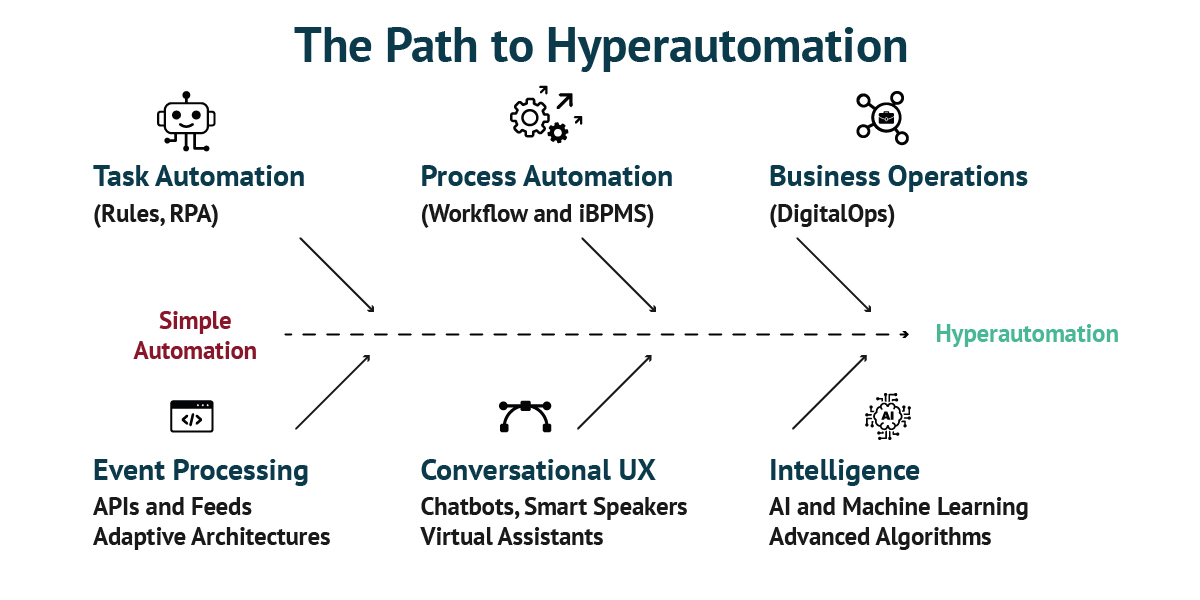In our last blog, we discuss the use cases of simple automation in IT operations (ITOps). In this article, we will deep dive into hyperautomation and its usage.
Providing breakthrough IT operations requires IT Service Management (ITSM), DevOps, and other IT Operations leaders to deliver exceptional employee experiences and high-performing business applications efficiently and economically. Achieving these expectations is not an easy task. Today, IT organizations must support both legacy and cloud-native applications, deploy to hybrid clouds, target more frequent releases and changes, scale infrastructure for growing data sets, and harden security measures against a growing number of threats.
It is becoming increasingly difficult to lead IT operations and improve experiences and services while driving efficiencies across large, more complex landscapes. To address this charter, many IT Ops leaders look to streamline workflows by augmenting IT staff’s skills and decision-making competencies with a library of automation that supplements people’s capabilities. Advancing these initiatives towards hyperautomation will be critical for IT success in an increasingly complex environment.
Hyperautomation is a term coined in 2019 by the IT research and advisory firm Gartner. Also referred to as digital process automation or intelligent process automation, hyperautomation provides a framework or an infrastructure of advanced used for scaling automation capabilities in an enterprise. It includes Robotic Process Automation (RPA) and is augmented by AI and machine learning with the ultimate goal of further automating already automated processes.

A hyperautomation practice can be broken down into three steps:
Hyperautomation makes it easier to infuse AI and machine learning capabilities, and in turn, simplifies the development and automatic generation of new automation prototypes. For example, under the umbrella of AI technologies, Natural Language Processing (NLP) lets the bot interpret human speech. Similarly, Optical Character Recognition (OCR) enables the bot to convert images to readable text. This capability allows hyperautomation to convert unstructured data into structured data, hence allowing access to data that has traditionally been inaccessible.
Apart from automation, Machine Learning (ML) tools of hyperautomation enable the bot to identify patterns in the data, offering an enterprise powerful analytical tools and capabilities that were previously unavailable.
The potential of using hyperautomation in IT Ops is significant. For example, auto-discovery and dependency mapping is hyperautomation that can collect various data types on a defined schedule. Teams can use this data to uncover insights and support ITSM processes. IT departments must track highly elastic infrastructures wherein the capacity needed for computation, storage, and network rises or falls based on demand.
Another area of hyperautomation for a breakthrough in IT operations is the implementation of an AI operations solution that centralizes the data and then uses machine learning to correlate alerts from multiple systems into a time-sequenced incident. Additionally, Robotic Process Automation (RPA) is a useful tool when you want to automate legacy business processes. But that’s not enough for IT processes, we need to combine it with Intelligence automation to get an end-to-end automation process.
Digital transformation is about reinventing future business models and intelligent operations. It requires ongoing reinvention and bringing together people’s strengths in collaboration, decision-making, and innovation with technology and data capabilities.
Low-code platforms such as the Nintex automation platform, deliver this connection by enabling rapid development and easy support of the connections in the form of applications, integrations, visualizations, and task automation.
Those on a hyperautomation drive realise that it is essential to make their IT operations more efficient by providing a collaborative ecosystem of automated processes. Although there may be a set of challenges – these are resolvable and can be dealt with to ensure the successful adoption of hyperautomation.
At AMO, our team’s expertise and delivery practice are centered around achieving user-centric custom automation solutions. We have assisted our customers’ IT teams to improve their resource utilisation while benefiting from a lower time to value and a reduction in costs.
Need advice on your automation initiatives, get in touch with our team today!
We gather information about your needs and objectives of your apps. Unsure about the app you need? We will carefully assess your top challenges and provide expert guidance on the perfect solution tailored to your success.
We create wireframes and an interactive prototype to visualise the app flow and make changes as per your feedback.
Estimation of the project deliverables including the resources, time, and costs involved.
Showcasing POC to relevant stakeholders illustrating the functionalities and potential of the app to meet business objectives.